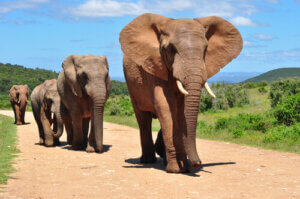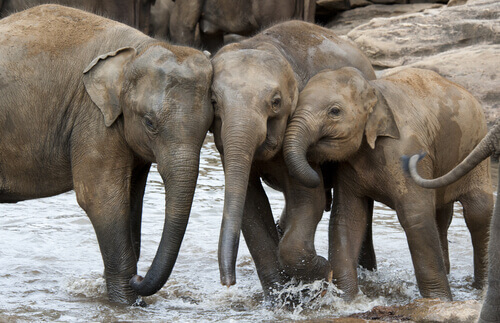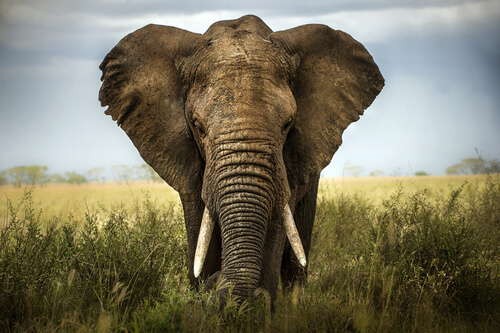Differences Between Asian and African Elephants

Do you know the differences between Asian and African elephants? These two animals, the largest mammals that walk our planet, have subtle but defining characteristics. Read on to learn how to distinguish them.
Differences between Asian and African elephants
The elephants of both continents are similar in their general appearance. Elephants are very large, weighing up to seven tons; the African elephant is, in fact, the largest land mammal in existence.
As for similarities, both are social and intelligent animals. They live in groups of different sizes, but they’re also sociable with other animals – mainly with humans, but there are also known cases of elephants making friends with dogs or cats. As for their intelligence, the ‘elephant memory’ and their ability to remember faces or places is famous.
Their habitat
One of the first differences between Asian and African elephants is obviously their habitat. African elephants live all over Africa except for the north and the desert. They’re always on the move and can travel long distances in search of water and food.
In contrast, the Asian elephant is concentrated in a few places in Southeast Asia: in Sri Lanka, Bangladesh, India, Sumatra, and Borneo. Many centuries ago their populations extended much further north, to China, but they have retreated over time.
The tusks
Another difference between the two species is in their tusks: both males and female African elephants have long ivory tusks. In contrast, only male Asian elephants have full tusks; not all females grow them and they’re usually small.
Size
The African elephant is the largest mammal on earth, while the Asian elephant is a little smaller. African elephants can measure up to 11.5 feet tall and almost 23 feet long; they weigh around five or six tons.

Asian elephants, on the other hand, are a little smaller – 6.5 feet in height up to the withers (shoulders), and weighing up to five tons. They’re still big animals, but not as impressive as their African cousins.
Their trunks
The end of the trunk is one of the most notable differences between Asian and African elephants. The Asian species has only one movable ‘finger’, while the African has two.
This means the trunk of the latter looks more like a hand, and it’s easier for it to grasp things. All the same, both types of elephant use their trunks to grab things and put them in their mouths or move them around. In the same way, they both collect water with their trunks to drink.
The shape of their shoulders
The shape of the back and shoulders is another difference. The Asian elephant’s back is arched, which makes its back the highest part of its body.
In contrast, the African elephant’s back is straighter and descends from the shoulders. The highest part of their backs is just behind the head; they can even look somewhat sunken.
The size of their ears
The most obvious difference between Asian and African elephants is the size of their ears, with those of the African elephant being much bigger.

The ears of the Asian elephant are rounded and relatively small: they barely cover the entire head. However, those of the African elephant are huge, and reach further back than their shoulders. This is because these animals use their ears to dissipate body heat, in addition to using them as a fan. In Africa, they live under more extreme conditions than in Asia.
So, when you see an elephant with ears almost as big as Dumbo’s, you’re looking at an African elephant. However, if they seem smaller in proportion to its head, and they’re also rounded, you can be sure it’s Asian.
Conservation status
There are many other differences between Asian and African elephants. The number of toes and the size of the tail are others, but those listed here are the most notable. But there’s one very important thing that they have in common: they’re endangered.
Both families are on the lists of threatened animals. They’re endangered mainly because of poaching. Hunters kill them for the ivory in their tusks.
Both types of elephant also face the disappearance of their habitats, which are being steadily destroyed in order to create pastures for cattle or for the construction of housing for humans. Fortunately, many countries have protected natural parks which ensure elephants can live in peace.
Asian and African elephants are the largest land mammals on Earth. There are a few differences between them: some are only small details and others are more noticeable to the naked eye.
Do you know the differences between Asian and African elephants? These two animals, the largest mammals that walk our planet, have subtle but defining characteristics. Read on to learn how to distinguish them.
Differences between Asian and African elephants
The elephants of both continents are similar in their general appearance. Elephants are very large, weighing up to seven tons; the African elephant is, in fact, the largest land mammal in existence.
As for similarities, both are social and intelligent animals. They live in groups of different sizes, but they’re also sociable with other animals – mainly with humans, but there are also known cases of elephants making friends with dogs or cats. As for their intelligence, the ‘elephant memory’ and their ability to remember faces or places is famous.
Their habitat
One of the first differences between Asian and African elephants is obviously their habitat. African elephants live all over Africa except for the north and the desert. They’re always on the move and can travel long distances in search of water and food.
In contrast, the Asian elephant is concentrated in a few places in Southeast Asia: in Sri Lanka, Bangladesh, India, Sumatra, and Borneo. Many centuries ago their populations extended much further north, to China, but they have retreated over time.
The tusks
Another difference between the two species is in their tusks: both males and female African elephants have long ivory tusks. In contrast, only male Asian elephants have full tusks; not all females grow them and they’re usually small.
Size
The African elephant is the largest mammal on earth, while the Asian elephant is a little smaller. African elephants can measure up to 11.5 feet tall and almost 23 feet long; they weigh around five or six tons.

Asian elephants, on the other hand, are a little smaller – 6.5 feet in height up to the withers (shoulders), and weighing up to five tons. They’re still big animals, but not as impressive as their African cousins.
Their trunks
The end of the trunk is one of the most notable differences between Asian and African elephants. The Asian species has only one movable ‘finger’, while the African has two.
This means the trunk of the latter looks more like a hand, and it’s easier for it to grasp things. All the same, both types of elephant use their trunks to grab things and put them in their mouths or move them around. In the same way, they both collect water with their trunks to drink.
The shape of their shoulders
The shape of the back and shoulders is another difference. The Asian elephant’s back is arched, which makes its back the highest part of its body.
In contrast, the African elephant’s back is straighter and descends from the shoulders. The highest part of their backs is just behind the head; they can even look somewhat sunken.
The size of their ears
The most obvious difference between Asian and African elephants is the size of their ears, with those of the African elephant being much bigger.

The ears of the Asian elephant are rounded and relatively small: they barely cover the entire head. However, those of the African elephant are huge, and reach further back than their shoulders. This is because these animals use their ears to dissipate body heat, in addition to using them as a fan. In Africa, they live under more extreme conditions than in Asia.
So, when you see an elephant with ears almost as big as Dumbo’s, you’re looking at an African elephant. However, if they seem smaller in proportion to its head, and they’re also rounded, you can be sure it’s Asian.
Conservation status
There are many other differences between Asian and African elephants. The number of toes and the size of the tail are others, but those listed here are the most notable. But there’s one very important thing that they have in common: they’re endangered.
Both families are on the lists of threatened animals. They’re endangered mainly because of poaching. Hunters kill them for the ivory in their tusks.
Both types of elephant also face the disappearance of their habitats, which are being steadily destroyed in order to create pastures for cattle or for the construction of housing for humans. Fortunately, many countries have protected natural parks which ensure elephants can live in peace.
Asian and African elephants are the largest land mammals on Earth. There are a few differences between them: some are only small details and others are more noticeable to the naked eye.
This text is provided for informational purposes only and does not replace consultation with a professional. If in doubt, consult your specialist.








